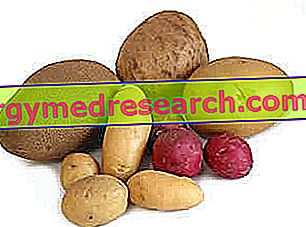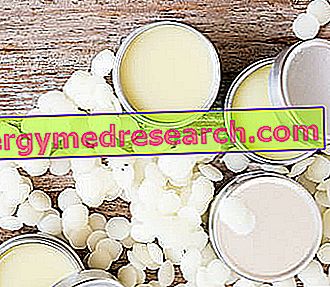Generality
The tubers are plant foods obtained by agriculture or collection of wild plants. They belong to the III group of foods and tend to owe their edibility to the cooking process (as happens with cereals and legumes).

The tubers are also used in animal nutrition, since they constitute the customary diet for some breeds such as the domestic pig and the wild boar. Finally, the tubers of some plants play a leading role in modern phytotherapy; it is the case of the Andean maca (tonic, immunostimulant), of the dioscorea (antioxidant and analgesic), of the konjac (bland laxative and anorectic) and of the lovage (diuretic, urinary and balsamic disinfectant).
Description
The tubers are plant structures and constitute only a part of the whole plant; in particular, it is a portion of the stem that takes on a rather squat shape (spherical and / or elongated) in which the vegetable crams its energy reserves. These consist essentially of complex carbohydrates, that is starch and / or inulin (not available for humans, but still important as a prebiotic dietary fiber).
The tubers tend to be placed in the lower portion of the trunk, well hidden below the earth's surface, and only very few Species develop them in the open. Tubers are NOT roots (such as carrots) or tuberous roots (such as sweet or American potatoes and cassava); They are NOT bulbs (garlic, onion, chives, shallots, etc.) nor truffles.
Edible tubers
The tubers are not all edible. Among the edible potatoes are well known, but the Jerusalem artichoke is also quite widespread. Others are not usually used for food but this does not mean that they are not edible; some obsolete examples are: Oxalis tuberosa, Tropaeolum tuberosum, Dioscorea bulbifera and Cyperus esculentus .
- Potatoes: potatoes (binomial nomenclature: Solanum tuberosum ) are the most common edible tubers in the world; we will not dwell on the specific description of the food and suggest users read the dedicated article: potatoes. The following will simply mention the varieties available on the market and the recommended ones: Agata potato (yellow pasta, early production), Amber potato (large and well-preserved), Imola potato (white paste, medium-late and well-preserved), Jaerla potato (globosa, yellow paste, smooth and clear peel, medium - early and drought resistant production), Kuroda potato (late, with red, rustic, disease resistant peel), Spunta potato (with regular and elongated shape, yellow paste, peel smooth and yellow, early and abundant production), Kennebec (white paste, late and abundant production, resistant to late blight, resistant to drought, suitable for home winter preservation).
- Jerusalem artichokes : Jerusalem artichokes (binomial nomenclature: Helianthus tuberosus ) are less common edible tubers than potatoes (especially nationally). The Jerusalem artichoke has a lower energy supply than the potato because it brings greater rations of inulin (dietary fiber) and lower amounts of starch. Even in this case we will not dwell on its food description, for which I suggest reading the dedicated article: Jerusalem artichoke.
Remember that there is also a wide range of non-edible and even poisonous tubers; some examples are: Arum maculatum and Cyclamen hederifolium.
Cultivation
In Italy, the most favorable areas for the production of tubers (mainly potatoes) are the alpine mountainous areas, since they allow these crops to develop a spring-summer cycle (from May to September). In the south, instead, the tubers are planted in autumn to obtain an early production.
The tubers undergo freezing at -2 ° C and undergo absorption disturbances from the soil with temperatures above 30 ° C. As can be deduced, the soils suitable for the cultivation of tubers (especially potatoes) are siliceous or siliceous - clayey, slightly acidic, loose and permeable, deep and rich in organic molecules. The tubers can be grown using two generally complementary systems: the first is that of sowing, the second is that of vegetative multiplication (transplantation of each portion of the sprouted tubers - clonal propagation).
WARNING! Even the edible tubers (and some berries such as tomatoes and aubergines) contain some toxic molecules; is the case of solanine. This glycoalkaloid is normally present only in the leaves and stem of potato plants, but when the tuber is exposed to sunlight it begins to take on a more greenish color and sprout developing solanine. For this reason, wrinkled and wrinkled potatoes contain higher amounts of toxin; to prevent this molecule from forming in the tuber, it is necessary to keep it in the dark, in cool places, and it is always advisable to cook the food thoroughly because the heat significantly reduces the concentrations.
Nutritional properties
Speaking of the nutritional properties of the tubers, it should be remembered that, in Italy, potatoes represent the main representative of the category.
The tubers are portions of the plant aimed at conserving energy reserves; these stocks, consisting of starch and / or inulin, can also be very useful for human nutrition. The tubers therefore have a predominantly energetic function (thanks to starch), but also prebiotic and intestinal preservation (by virtue of the presence of inulin).
The tubers are not edible raw and always require a fairly consistent cooking level, otherwise the digestibility and availability of energy nutrients would be negatively affected.
While the starch of the cooked tubers is well digestible and absorbable, inulin constitutes a molecule unavailable to the human body. This does not mean that it is useless, far from it! The inulin contained in the tubers is a fructose polymer whose monosaccharides are bound by β-glycosidic bonds; for this reason it is not easily digested by the digestive enzymes of human beings. On the other hand, this link is well divisible by some microorganisms; at the level of the large intestine, in particular, inulin is dismantled by physiological bifidobacteria that nourish it by developing excellently; this function is called prebiotic. In parallel and synergistically with this reaction, inulin is also one of the most common viscous fibers; in spite of the "relative" solubility, it favors a gelling of the faeces which pass in a simple and uncomplicated manner; for this reason the inulin of the tubers also plays an intestinal conservation role.
In the tubers, lipids are almost absent and proteins are scarce, as well as having a low biological value.
Among the salts of the tubers, we recall the excellence of potassium and some microelements such as zinc and selenium; with regard to vitamins, for potatoes there is a good supply of niacin (vit. PP) and ascorbic acid (vit. C - almost totally destroyed by cooking).
No more details are available on the nutritional content of the less consumption tubers.



